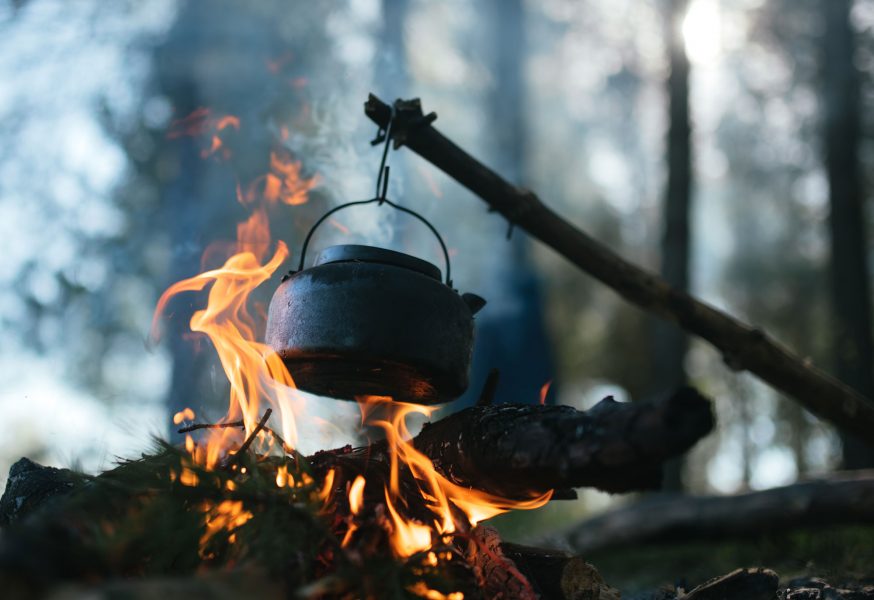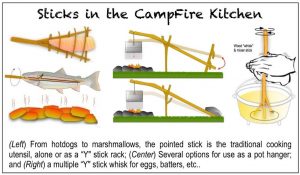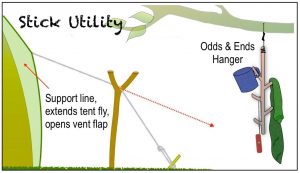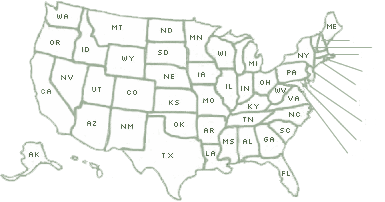
No matter how sophisticated your array of camping gear is by design and function, it can no doubt be enhanced even further by applying the use of a stick
In today’s world of high-tech outdoor equipment, there remains a basic, invaluable and indispensable tool older than history itself — the stick! Fundamentally all tools are a modification of the human hand, making the stick an extension of the human arm. No matter how sophisticated your array of camping gear is by design and function, it can no doubt be enhanced even further by applying the use of a stick (it, too, available in a variety of layouts and designs).
The most familiar and basic use of a stick is around the campfire — roasting a hot dog or a marshmallow on the end of a sharpened stick is the unspoken rite of passage for anyone who’s every spent a night out under the stars — or even cabin roof for that matter. More advanced uses in the campfire kitchen include using a forked stick (shaped like a “Y,” hence a “Y Stick”) to create a roasting rack for slabs of meat or whole fish.
[STICK TIP: When using a single stick for fish, sharpen a short side branch so when the longer stick is inserted into the fish, the side spur can be positioned to dig into the side and keep the fish in place when rotating over the coals. this prevents the heavy side of the whole fish from swinging down when the stick is turned to cook the other side.]

If you need to really fluff up a batch of eggs or batter, a multi-forked stick or a couple of Y-sticks held together and rapidly rotate back and forth by hand (like you were using a friction stick to start a fire), you can get nearly the same results as from using a whisk.
A cooking stick is a good tool for simply stirring; or placed across the top of a pot to support the wire handle and thus preventing it from heating up by lying down alongside the hot pot.
Beyond the camp kitchen, the Y-stick is most often used with the guylines on a tent or tarp to change the angle of pull without needed excessive line length to tie off to keep it tight. A long forked stick can be placed nearer the tent/tarp and used to raise the angle of the tension on the line without extending the line further out. A Y-stick lets you set the desired angle and then drop it at a shorter, steeper angle to the ground. This works on main support lines, tent awnings and anywhere along a camp tarp. The Y-stick can be easily moved to readjust the height/angle of the guyline throughout the day — raise for ventilation, lower for blowing rain, adjust for sun angle and shade, and much more.

Another handy use for a stick is an old Boy Scout trick. Trimming a small limb with multiple side branches becomes a hanging rack for many uses around camp. If it’s near your cooking area, you can hang utensils or cups; if it’s near where you wash up, it can hold your soap-on-a-rope, or towel. One hanging from a loop inside your tent vestibule can be a handy spot to stow anything with a lanyard or loop. If a clothes line isn’t practical, hanging several racks from a branch gives you plenty of “coat hooks” for even more garments and gear.
Solid dead sticks are preferable for most cooking as fresh wood can sometimes impart weird flavors into the food. However, green branches often work better for roasting food over direct heat and for hanging racks for clothing and gear.
The stick is the foundation for many emergency skills, too, from building survival structures to makeshift splits for broken bones. I’ve even used a stick to make an emergency shaft for an emergency Frisbee canoe paddle.
Be responsible in cutting down living foliage (willow and alder work well for many of these applications). If nothing else, whittling on a stick is a classic camp past time, adding yet another facet to the versatility of the pre-historic/modern day stick.
Tom Watson is an award-winning outdoor safety and skills columnist and author of guide books on tent camping, hiking and self-reliant survival techniques. His website is www.TomOutdoors.com.
 Your Privacy Choices
Your Privacy Choices

